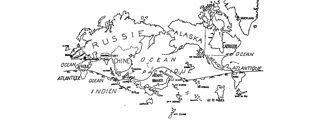BCU researcher Dr. Lauren Walden, based in the Centre for Chinese Visual Arts, has recently completed a three-year research project as a Leverhulme Early Career Fellow where she expands the cultural memory of the Surrealist movement beyond western boundaries.
LAUREN WALDEN
Leverhulme Early Career Fellow in Contemporary Chinese Art
“It’s well known that art history as a discipline has a problem with Eurocentrism. One of the more surprising aspects of this, however, is that experimental, avant-garde movements that critiqued the colonialism of the west, remain very much western in our cultural memory. Indeed, the Surrealist Map of the World (1929) resized nations to undermine western political domination, instead focussed on the cultural prowess of a territory.
In art history, we often think of the avant-garde as a fundamentally original break from tradition, such as narrative pieces depicting real life scenes with a focus on rationality.
Yet, if we look closer, many concepts in traditional Chinese art foreshadow western avant-garde practices. Western surrealists referred to the spontaneous aspects of Chinese calligraphy comparing it to their notion of automatism or creating without forethought. Moreover, they cited China’s religion of Daoism and the dichotomy of yin/yang to show how opposing forces can coexist, much like their own concept of a ‘supreme point’ where ‘life and death, the real and the imagined, past and future, the communicable and the incommunicable, high and low, cease to be perceived as contradictions’ (Breton: 1929). As such, many Chinese traditions could be viewed as surrealist before the term was even invented.
A huge methodological issue in Chinese contemporary art is the notion of Chinese artists ‘copying from the west’, which becomes somewhat ironic considering my previous discovery.
Chinese artists are often accused of a supposed pillaging of different avant-garde styles and mixing them together. In fact, my research shows that Chinese contemporary artists were well-versed in the philosophical heritage of surrealism reading widely on notions of the subconscious through Freud for example, sifting through information and making informed choices.
Surrealism’s reconciling of opposites enabled Chinese artists to reflect on the vicissitudes of 20th and 21stCentury history where colonialism and cosmopolitanism (pre-revolution), collective revolution and individual subjectivity (Maoist era) then communism and capitalism (post-socialist) would coexist side by side.
For example, the artist Zhao Shou, who translated Surrealist founder André Breton’s manifesto into Chinese in 1935, utilised Pablo Picasso’s technique of distortion as a means of psychologically invoking a sense of alienation and a dichotomy between the public and private self in a Chinese teahouse during the Cultural Revolution (1966-1976) , a cataclysmic decade of intellectual, class-based repression that the Chinese Communist Party would later criticise in a resolution of 1981 after beginning political and economic reforms in the wake of Mao’s death.
As such, my research has fleshed out a duality of Surrealist practice in China as the product of ‘historico-intrinsic relations’ to assert that Surrealism is the avant-garde movement that chimes most with traditional Chinese thought whilst being deployed as a tool to reflect and refract contemporaneous social issues.”
Over the course of the fellowship, I’ve been fortunate enough to have the time to write a full-length monograph and two journal articles, complete a short form monograph and convene a conference from which I have edited a double edition of the Journal of Contemporary Chinese Art.
I have been able to directly communicate my research findings at BA, MA and PhD level, gaining fellowship of the higher education academy and a SEDA award in Supervising Postgraduate Research. I hope that this can feed into more widespread efforts to decolonise the curriculum, making global art an integral part of the student experience at BCU."
